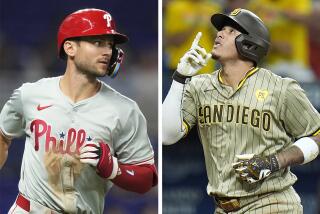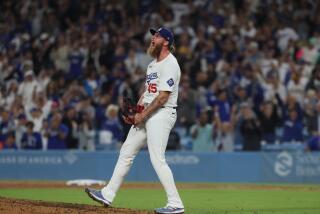Reds’ Throw-Away Wound Up a Keeper
Trading in baseball is almost a lost art. But even in its heyday, it used to be axiomatic that the best trades are often the ones you never make.
This is because the worst ones are so highly visible. And humiliating. They haunt the general manager for the rest of his baseball life.
The worst trade in the history of the major leagues is a matter of subjective evaluation, but in the hunt has to be the dealing of Frank Robinson to the Baltimore Orioles for right-handed pitcher Milt Pappas. A baseball rule of thumb is, never trade a pitcher unless you get plenty.
The Orioles got plenty. Robinson not only became one of only 13 players in the modern history of the game to win the triple crown (batting average, home runs, runs batted in), but he was the catalyst in leading Baltimore to a succession of pennants, World Series victories and chronic contending position. Robinson made the Hall of Fame. Pappas went 46-47.
St. Louis appeared to be violating the never-trade-a-pitcher principle when they sent right-hander Ernie Broglio to the Chicago Cubs for outfielder Lou Brock. Broglio was an 18-game winner the year before. But he went 14-31 for his career at Chicago and was out of the game in three years. Brock went on to the Hall of Fame, set the major league stolen base record and helped the Cardinals to several World Series, where he usually batted .400 and set stolen base records.
Those trades were bad. But how about trading Grover Cleveland Alexander in his prime for--are you ready?--Pickles Dillhoefer?! Alex had only won 30 games that year and was to win 373. The immortal Pickles, a catcher, went on to bat .123, .091 and .213 in his next three seasons.
It’s a risky business. It used to be the only way a player could travel from one club to another. Player movement today is dictated by the player. He goes when he wants, where he wants, and he gets the money, not the seller, the club owner.
A general manager, however, still has to be nervous approaching a bargaining session. Dennis Eckersley went to Oakland for three minor league players three years ago--the immortal David Wilder, Brian Guinn and Mark Leonette. Philadelphia got Steve Carlton (and two pennants) for Rick Wise.
The “trade that will help both clubs” exists only in the team’s publicity handout. The trade that helps neither club is the more likely .
The “throw-ins,” i.e., players considered of no importance but put in to sweeten the attraction, and the “player to be named later” have sometimes enjoyed a significant role. Sid Bream, an afterthought in the deal that sent Bill Madlock from Pittsburgh to the Dodgers, is enjoying productive years with the Pirates.
So, when Dodger General Manager Fred Claire approached the negotiating table with the Cincinnati Reds last summer, he knew he had to keep one hand on his wallet and the other on a Bible. The worst thing you can do is make a mistake trading with a team not only in your league but in your division--the team you have to beat. He knew what he needed. He wanted another bat in the lineup--Kal Daniels, a natural .300 hitter with good power, was perfect for his purposes. He knew what Cincinnati needed--a pitcher.
Claire offered Tim Leary, a right-hander of great promise who had one 17-game season with the Dodgers but had struggled to achieve consistency much of his career.
The Reds countered they would need something else. The Dodgers threw in Mariano Duncan, a sometimes brilliant but erratic shortstop who had trouble hitting the major league curveball. When Cincinnati acquiesced, Claire pressed his luck. He wondered whether he shouldn’t have a throw-in of his own. He got Lenny Harris, a good-enough ballplayer but one who found it so difficult to find a spot to break in the lineup that he took to wearing four gloves. To stay in the big leagues, he found he had to play wherever a spot opened up, either through injury or poor play on the part of the incumbent.
It’s a tough way to launch a career, but Harris had the perfect temperament for it--uncomplaining, cheerful. A utility infielder has to be like a butler. Ready to serve wherever he’s needed.
The Dodgers were delighted. On a team where cheerful acceptance is not in abundance, Harris was a breath of fresh air. Or at least, fresh attitude.
Not since Jim Gilliam, have the Dodgers had a player who could roam between the infield and outfield and play either position with equal skill and enthusiasm.
“He’s an outstanding young man,” insists his manager, Tommy Lasorda. “He’s a Dodger! I platoon him with Mike Sharperson, that’s OK. I need him at second base, that’s OK. We need him in the outfield? Lenny runs out there. When Fred Claire called me and said, ‘We have a chance to get Lenny Harris,’ I said, ‘Get him!’ I remember one game against us, he went after a foul ball and he slammed clear into the fence. But he caught it.”
Daniels is hitting a predictable--and satisfactory--.290 with 19 home runs and 62 runs batted in. Tim Leary, after a disappointing season, was traded to the New York Yankees, with whom he is having a mediocre year.
But the throw-ins are prospering. Duncan is batting a rarefied .327, almost 100 points above his lifetime average.
And Harris is hitting a robust .296 after hovering around .300 most of the year.
Harris is even content with his stand-in role. “I try to keep myself ready, keep myself concentrated. I play where I’m needed. If they need a leadoff man, I hit leadoff. When I knew they wanted me to lead off, I went to Brett Butler (of San Francisco) and asked him for some pointers on how to play it. He told me what you need is patience.”
Harris has that. He is patient, low profile. On a recent evening, he was found patiently standing at the fence signing baseballs and gloves for a line of young fans.
He won’t even bad-mouth a system that has scarcely let him get a full season under his belt to learn his trade the only place you can--on the field. “Oh,” he says, “Pete (Rose) played me whenever he could, whenever he had a place for me. I couldn’t complain.”
He could have. He just didn’t.
A baseball trade is like any other business merger. You have to wait a while for the bottom line. So far, Lenny Harris has made the Dodgers look as if they’ve made the best deal since Wally Moon for Gino Cimoli. Or maybe since Grover Alexander for Pickles Dillhoefer.
More to Read
Go beyond the scoreboard
Get the latest on L.A.'s teams in the daily Sports Report newsletter.
You may occasionally receive promotional content from the Los Angeles Times.










